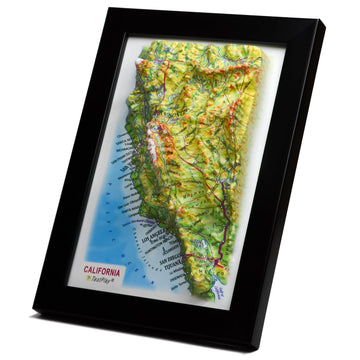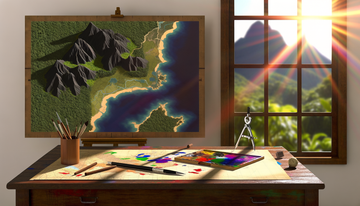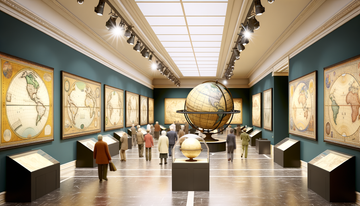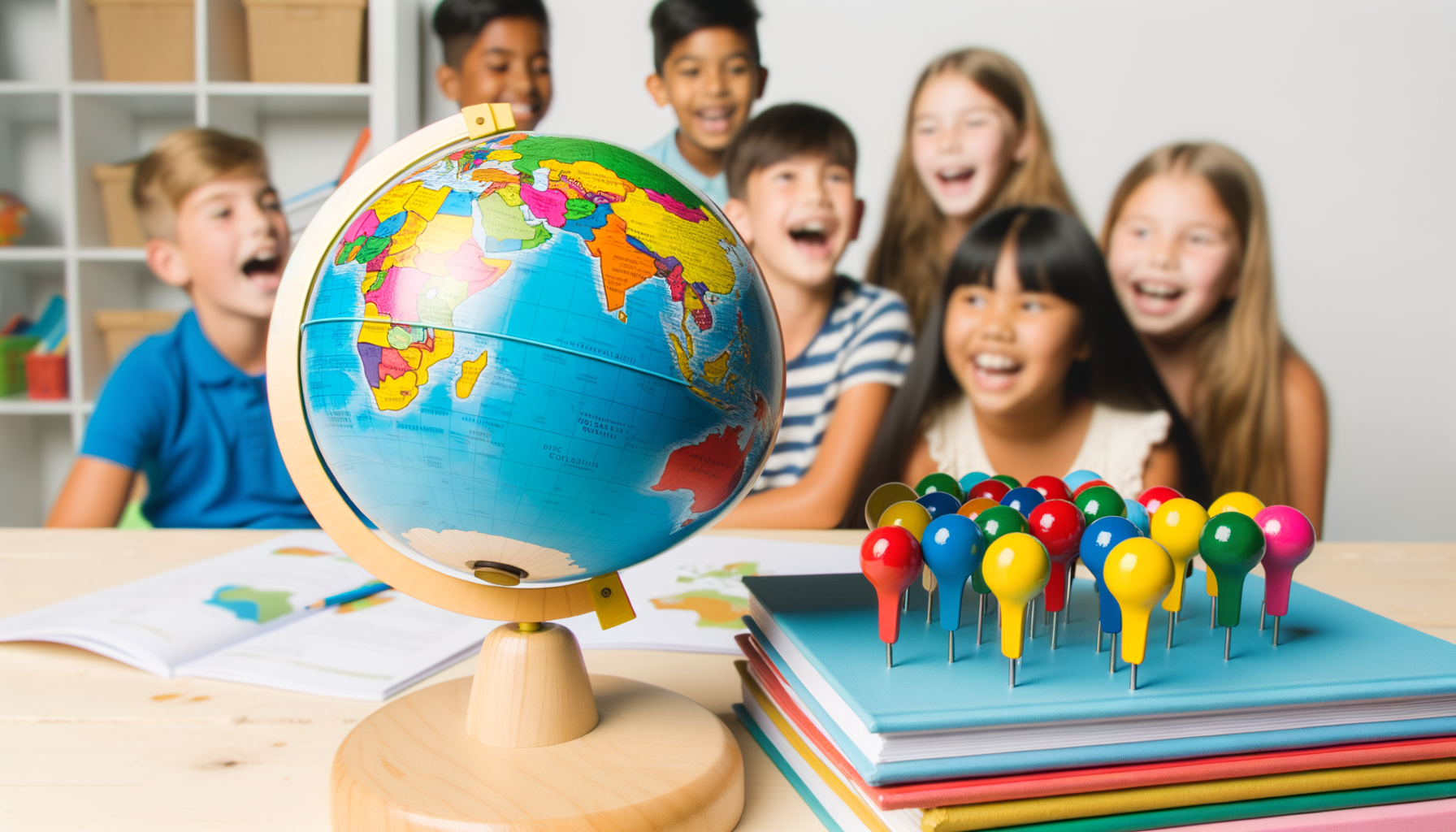The Best Globes for Kids: Make Geography an Exciting Adventure
Learning about the world is one of the most crucial parts of a child's education.
Understanding geography helps them comprehend history, current events, cultures, and the interconnectedness of our planet.
However, for many children, geography can sometimes feel like memorizing dry facts from a textbook or a flat, distorted map.
Fortunately, there is a classic, effective, and increasingly innovative tool that can bring the world to life right in your home or classroom: the globe.
A globe offers a true representation of the Earth, allowing children to grasp spatial relationships and visualize distances in a way flat maps simply cannot replicate.
Finding the *best* globe for your child involves navigating various types and features to match their age, interests, and learning style.
This comprehensive guide will walk you through why globes are indispensable learning tools, the different kinds available, what features to prioritize, and how to choose the perfect globe to make learning geography a truly fun and engaging adventure for your child.
Get ready to explore the possibilities and find a tool that will spark curiosity and foster a lifelong love for understanding our amazing planet.
Why Globes Are Essential Learning Tools for Children
In a world increasingly dominated by digital screens, the tactile and visual experience of a physical globe remains incredibly valuable for young minds.
Unlike flat maps which inevitably distort sizes and shapes of continents and countries (think about how huge Greenland looks on a standard map versus its actual size relative to Africa on a globe), a globe presents the Earth's true spherical form.
This fundamental difference provides a crucial foundation for understanding global geography accurately from the outset.
Visual and Spatial Understanding
A globe is the most accurate scaled model of the Earth we have readily available.
Holding and turning a globe allows children to intuitively grasp concepts like the planet's rotation, the tilt of its axis (if the globe is mounted correctly), and the relative positions of landmasses and oceans.
They can see how continents are connected, how oceans separate them, and get a real sense of distance and direction around the sphere.
This spatial understanding is not just about memorizing locations; it builds a cognitive framework for processing geographical information.
It helps children visualize journeys across the planet, understand why climates vary by latitude, and appreciate the vastness and diversity of different regions.
This foundational understanding is much harder to build using only two-dimensional representations.
Contextualizing World Events and History
When children hear about events happening in different parts of the world, locating these places on a globe provides immediate context.
Hearing about something in Ukraine feels different when you can see its position relative to Europe and Asia, or learn about an earthquake in Japan and immediately locate it on the Pacific Ring of Fire.
Globes make abstract news stories tangible by grounding them in physical space.
Similarly, studying history comes alive when children can trace the routes of explorers, visualize empires that spanned continents, or understand the geographical challenges faced during historical conflicts.
Seeing the distance between Europe and the Americas on a globe provides a much better appreciation for the daring voyages of Columbus or the early settlers than looking at a flat world map.
Sparking Curiosity and Imagination
Perhaps one of the most important benefits of a globe is its ability to ignite a child's natural curiosity.
Spinning the globe and pointing to a random spot can lead to questions like "What is it like there?" or "Who lives here?"
It encourages exploration, asking questions, and seeking out information about different countries, cultures, animals, and environments.
A globe isn't just a tool for learning facts; it is a gateway to imagination.
Children can dream of traveling the world, imagine the landscapes of distant lands, and develop a sense of wonder about the planet we inhabit.
It transforms geography from a chore into an exciting invitation to explore.
Navigating the World of Kids' Globes: Types to Consider
Just as there are different types of learners, there are different types of globes designed to cater to various needs and interests.
Understanding the options available is the first step in choosing the best globe for your child.
From traditional models to high-tech interactive spheres, the variety is impressive.
Traditional Political Globes
This is likely the type of globe that comes to mind for most people.
Traditional political globes typically show countries delineated by different colors, with borders clearly marked.
They feature major cities, national capitals, latitude and longitude lines, and perhaps major bodies of water labeled.
These globes are excellent for teaching political geography, understanding countries, continents, and national boundaries.
They are straightforward, require no batteries or internet, and provide a solid, classic learning experience.
Look for clear labeling and up-to-date political information, although political boundaries can change, making recent models preferable.
Physical/Topographical Globes
Physical globes focus on the Earth's natural features rather than political divisions.
They use different colors to represent elevation (greens for lowlands, browns for mountains) and may have raised relief to show mountains, valleys, and other landforms tactilely.
These globes are fantastic for teaching physical geography, helping children understand landscapes, mountain ranges, deserts, and ocean depths.
Some globes combine both political and physical features, often using color to denote physical characteristics but also showing political borders.
For a truly immersive understanding of the Earth's surface, a physical or combined globe is a great choice.
Illuminated Globes
Illuminated globes serve a dual purpose: they are educational tools and also function as appealing room decor or night lights.
When the light inside is off, they often display political boundaries or physical features.
When the light is turned on, the map may change to reveal different information, such as physical topography, constellations, or even internal views of the Earth.
The illumination adds a fascinating visual element that can make studying the globe more engaging, especially in dim light.
Ensure the cord is safely managed, especially in a child's room, and check what map is displayed when the light is both on and off to understand its full functionality.
Interactive Globes
Interactive globes bring technology into traditional geography learning.
These often come with a stylus or a special pen that, when touched to different locations on the globe, triggers audio responses.
The pen might provide information about countries, capitals, languages, populations, currency, or play national anthems.
Some interactive globes offer quizzes and games, making learning dynamic and test knowledge in a fun way.
They are particularly good for auditory learners and children who enjoy gadgetry and immediate feedback.
Check the range of information provided and the quality of the audio.
Inflatable Globes
Inflatable globes are perhaps the most budget-friendly and versatile option, especially for very young children or active play.
Made of durable vinyl, they can be used indoors or outdoors and are lightweight and portable when deflated.
While the map detail might be less precise than on rigid globes, they are great for introducing basic concepts like continents and oceans through games like catch or identifying locations.
They are also excellent for classroom use where multiple globes are needed or for travel.
Their soft nature makes them safe for younger children, and they are easy to store.
Look for ones with clear, reasonably accurate printing for the price point.
Augmented Reality (AR) Globes
Representing the cutting edge of globe technology, AR globes use a standard physical globe in conjunction with a smartphone or tablet app.
When you point the device's camera at the globe through the app, digital information is overlaid onto the physical sphere.
This allows children to see layers of information like animal habitats, famous landmarks, dinosaur locations, weather patterns, celestial bodies, and much more appear directly on the globe's surface on their screen.
AR globes offer an incredibly engaging and visually stimulating way to explore diverse topics related to geography, science, and culture.
They are best suited for tech-savvy families and children who enjoy interactive digital experiences combined with physical objects.
Ensure the companion app is well-supported and offers a good range of content.
What to Look for When Choosing the Perfect Globe
Selecting the right globe involves more than just picking a type; you need to consider several key features to ensure it meets your child's specific needs and provides lasting educational value.
A well-chosen globe will be a cherished learning tool for years to come.
Age Appropriateness and Durability
Consider the age of the child you are buying for.
Younger children need globes that are robust, perhaps with simpler mapping and fewer small details, and certainly durable enough to withstand being dropped or handled frequently.
Inflatable globes or sturdy, simplified political globes are often best for this age group.
For older children and teenagers, globes with more detailed mapping, perhaps showing topography or offering interactive features, will be more appropriate and engaging.
Ensure the materials are durable enough for regular use, whether it's hard plastic, metal, or quality paper mache over a strong core.
A stable base is also crucial, especially for younger users.
Clarity and Detail (Maps, Labels)
Examine the quality of the map printing.
Are the colors clear and distinct? Is the text (labels for countries, cities, rivers, etc.) legible and appropriately sized for the globe's scale?
For political globes, check that borders are easy to see.
For physical globes, assess how clearly different elevation levels are represented and if raised relief is included, how pronounced and accurate it feels.
Too much clutter can be overwhelming, especially for younger children, while too little detail might not satisfy older, more curious minds.
Find a balance that suits the intended user.
Size and Scale
Globes come in various diameters, from small desk models to large floor-standing versions.
Consider where the globe will be used and stored.
A larger globe generally allows for more detail and is easier to read from a distance, making it great for classrooms or shared family spaces.
Smaller desk globes are convenient for personal use or limited space.
The scale of the globe determines how much detail can be included; a larger diameter means a larger scale (e.g., 1 inch equals fewer miles), allowing for more cities, rivers, and smaller geographical features to be shown clearly.
Think about how the globe will be used most often when deciding on size.
Features and Interactivity
Beyond the basic map, consider extra features.
Does an illuminated globe offer different maps when lit?
Does an interactive globe provide a wide range of information and engaging activities?
Does it have raised relief for a tactile experience?
Some globes include features like a meridian (the ring around the globe) that is marked with degrees, allowing you to measure distances or determine latitude and longitude more precisely.
Others might have built-in games or accompanying booklets.
Decide which extra features align with your child's interests and preferred learning methods.
Base and Stand Stability
The base and stand are crucial for the globe's usability and safety, especially with younger children around.
A wide, heavy, and stable base prevents the globe from tipping over easily during use.
Check the material of the base (wood, metal, sturdy plastic) and how securely the globe sphere is mounted.
Some stands allow the globe to tilt or rotate freely, offering more flexibility for viewing different angles.
Others are fixed.
Consider how the globe will be used – will it be stationary on a desk, or moved frequently?
A good stand ensures the globe is easily accessible and safe to use.
Accuracy and Updates
Political boundaries can change over time.
While a slightly outdated globe is still valuable for general geography and physical features, for learning current political geography, look for a globe that has been recently updated.
Check the copyright or publication date if available.
For interactive or AR globes that rely on digital information, consider how often the accompanying app or software is updated.
An app that receives regular updates will provide more current information and potentially new features over time.
Accuracy in labeling and mapping is fundamental to the globe's educational purpose.
Top Picks and Categories: Finding the Right Globe for Your Child
Instead of listing specific brand names which change often, let's look at categories of globes that consistently perform well for kids based on common needs and features.
This approach helps you identify the *type* of globe that will be the best fit, allowing you to then seek out highly-rated models within that category.
Consider these categories as starting points for your search.
Best Traditional Globe for Young Learners
For introducing basic geography concepts to children aged 5-8, a simple, sturdy, and clearly labeled political globe is often ideal.
Look for bright, distinct colors for countries and large, easy-to-read text for major place names and oceans.
Durability is key, so models made from robust plastic with a stable base are preferable.
Raised relief on continents can add a fun tactile element for little hands to explore mountains.
The best in this category prioritize simplicity and resilience over intricate detail, making the world accessible and inviting for young children.
They focus on the big picture: continents, oceans, and major countries.
Best Interactive Globe for Older Kids
For curious minds aged 8 and up who enjoy technology and learning facts, an interactive talking globe offers deep engagement.
These globes provide a wealth of information on demographics, cultures, history, and more, often through audio responses triggered by a stylus.
Many include quiz modes that turn learning into a game, perfect for solo play or family challenges.
Look for models with a wide variety of topics covered and clear, engaging audio.
The best interactive globes offer different levels of difficulty or information depth, growing with your child's knowledge.
They transform the globe from a static object into a dynamic source of knowledge and fun.
Best Budget-Friendly Option
You don't have to spend a fortune to get a valuable geography tool.
High-quality inflatable globes are incredibly affordable and offer surprising detail for their price.
They are perfect for casual learning, travel, or group activities.
Smaller, traditional desk globes made of sturdy materials can also be found at reasonable prices.
While they might lack the bells and whistles of more expensive models, they still provide that essential spherical representation of the Earth.
Prioritize clear map printing and durability even in this category.
Best Globe for Display and Learning
If you're looking for a globe that is not only educational but also aesthetically pleasing enough to be a centerpiece in a room, consider illuminated globes or larger, well-crafted traditional globes with attractive bases.
An illuminated globe that shows political boundaries when off and physical topography when lit offers both visual appeal and varied learning.
Larger globes, especially those with detailed political and physical mapping and perhaps raised relief, offer an impressive visual scale that encourages closer study.
A beautiful globe can serve as a constant invitation to learn and explore, blending educational utility with elegant design.
Look for quality construction and clear, detailed cartography.
Most Innovative (AR) Globe
For families eager to embrace modern technology in learning, Augmented Reality globes offer a unique and futuristic experience.
Combining a physical globe with a companion app allows children to see digital layers of information overlaid onto the real-world object.
This approach can make learning about diverse topics like dinosaurs, world cuisines, or famous landmarks incredibly dynamic and visually rich.
The best AR globes have well-designed, stable apps with a wide range of regularly updated content.
This category is perfect for engaging tech-savvy kids and presenting geographical information in novel, exciting ways.
Ensure compatibility with your devices and check reviews of the accompanying app.
Bringing the Globe to Life: Engaging Activities and Learning Games
Simply having a globe is a great start, but actively using it is what truly unlocks its educational potential.
Incorporating the globe into games and learning activities makes geography memorable and fun.
Here are some ideas to get you started, suitable for various ages.
Globe Scavenger Hunts
Create a list of places (countries, cities, oceans, famous landmarks, mountains) for your child to find on the globe.
Start with familiar places and gradually introduce new or more challenging locations.
This activity helps children practice locating specific places and reinforces their understanding of continents and relative positions.
For younger children, you can provide clues like "Find the country shaped like a boot" (Italy) or "Find the ocean with lots of islands" (Pacific).
For older kids, challenge them with coordinates, finding capital cities, or identifying which country is south of another specific country.
Make it a timed challenge for extra excitement!
Tracking Journeys (Real and Imagined)
Use the globe to follow the routes of real or fictional journeys.
If you read a book set in a different country, find that country on the globe.
Trace the flight path if family members travel, discussing the continents and oceans they crossed.
Explore historical journeys, like Ferdinand Magellan's circumnavigation or the Lewis and Clark expedition, by finding the starting and ending points and tracing their likely paths.
This helps connect geography to history, literature, and personal experiences, making the world feel smaller and more connected.
It also reinforces concepts of distance and direction on a spherical surface.
Weather Watch and Climate Zones
Connect daily weather reports to global climate patterns using the globe.
Locate cities mentioned in weather forecasts around the world.
Discuss why places near the equator are generally hotter than places further north or south.
Use the globe to visualize climate zones (often represented by colors on physical globes or shown via AR apps).
Talk about how mountains affect weather or how ocean currents influence coastal climates.
This links geography to science and helps children understand the forces that shape our planet's environment.
Capital Cities Challenge
A classic geography game! Point to a country and ask your child to name its capital, or name a capital city and ask them to find the corresponding country.
Start with major, well-known countries and expand gradually.
Interactive globes with quiz features are perfect for this game.
You can turn this into a competitive family game night or use flashcards alongside the globe.
Learning capitals provides anchors for understanding countries and their political centers.
It's a foundational piece of political geography that the globe makes visual and accessible.
Integrating with Other Subjects (History, Science)
Actively look for opportunities to bring the globe into lessons from other subjects.
When learning about ancient Egypt, locate it on the globe relative to your own location.
Studying plate tectonics? Use a physical globe to show where major mountain ranges and fault lines are located.
Reading about different animals? Find their habitats on the globe and discuss the climate and geography of those regions.
The globe is a powerful tool for showing the interconnectedness of knowledge.
It helps children see that geography isn't an isolated subject but the stage upon which history unfolds and science operates.
Beyond the Sphere: Complementary Geography Resources
While a globe is an exceptional tool, it is just one piece of the puzzle when it comes to building a comprehensive understanding of geography.
Combining globe use with other resources can enrich your child's learning experience and provide different perspectives on the world.
These resources can reinforce what they learn from the globe and offer information that a globe alone cannot.
Atlases and Maps
Atlases and maps offer detailed, zoomed-in views that a globe cannot provide.
They are excellent for exploring specific regions, states, provinces, or even cities in depth.
Atlases often include thematic maps showing population density, climate, resources, or historical information.
Using an atlas alongside a globe helps children understand how different scales work and allows them to transition between seeing the whole world and focusing on specific areas.
It also provides valuable practice with map reading skills, including using legends and scales.
Look for atlases designed specifically for children with clear layouts and engaging graphics.
Educational Apps and Websites
Numerous digital resources are available to supplement geography learning.
Educational apps can offer interactive games, quizzes, virtual field trips, and access to up-to-date statistics about countries.
Websites like National Geographic Kids or NASA's climate resources provide a wealth of articles, photos, and videos that bring different parts of the world and geographical concepts to life.
These digital tools can offer dynamic information, current events updates, and multimedia content that complements the physical experience of using a globe.
They are particularly useful for older children who are comfortable using technology for learning.
vetting the quality and educational value of the app or website before introducing it.
Geography-Focused Books and Stories
Children's books, from picture books about different cultures to non-fiction guides about specific countries or geographical features, can make geography relatable and engaging.
Stories set in different parts of the world offer a narrative way to explore places and people.
Combine reading with the globe by finding the locations mentioned in the books.
There are also many excellent reference books specifically designed to explain geographical concepts, types of landscapes, or world demographics in child-friendly language and visuals.
Reading about a place enhances the experience of finding it on the globe, adding layers of cultural and environmental understanding.
Libraries are a fantastic resource for finding a wide range of geography-related books.
Documentaries and Travel Shows
Watching documentaries or age-appropriate travel shows about different countries, natural wonders, or wildlife can be a captivating way to learn geography visually.
Seeing real footage of landscapes, cities, and people provides a sensory experience that maps and globes cannot.
After watching, locate the places shown on the globe to reinforce their position in the world.
Many streaming services offer educational content focused on geography, nature, and world cultures.
This is a passive form of learning, but when paired with active use of the globe, it becomes much more effective and helps solidify the connection between the abstract representation and the real world.
Choose content that is both informative and visually appealing for your child's age group.




